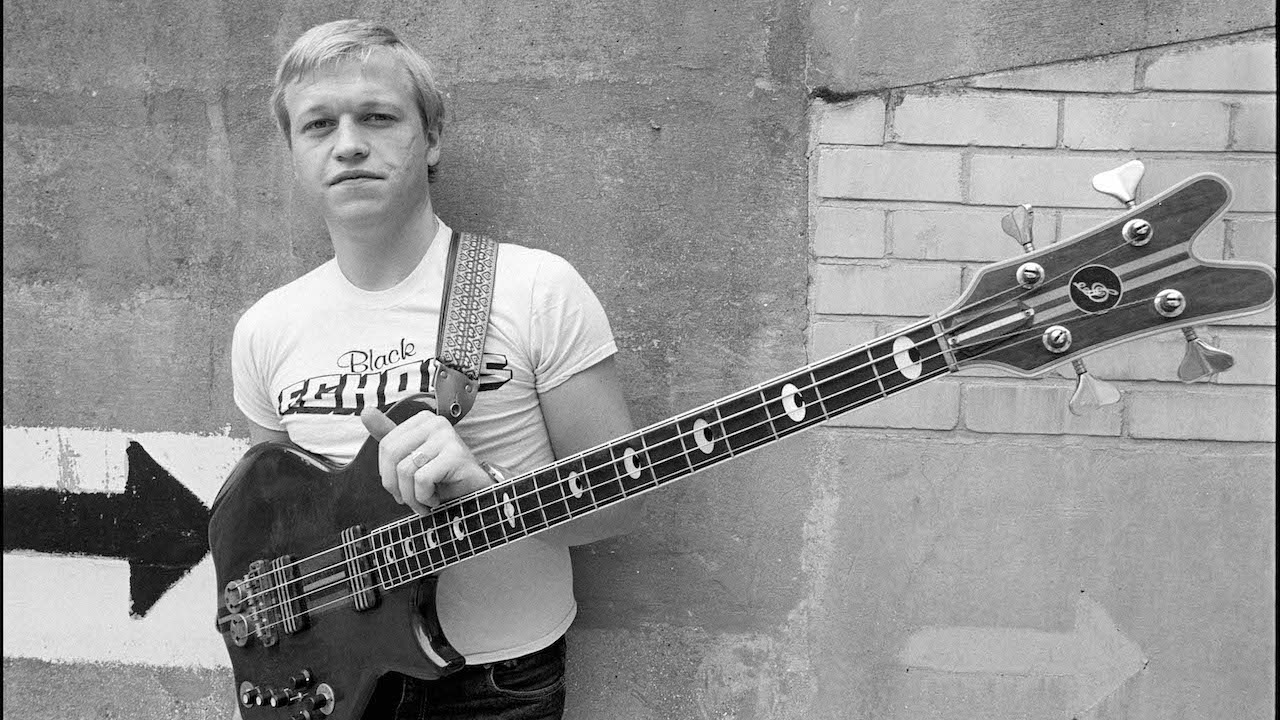Level 42 legend Mark King on his 5 most famous bass guitars
“This guy from Alembic showed up with a suitcase and said that he wanted to make a bass for me”

Echoing the likes of Stanley Clarke and Louis Johnson, Mark King’s slapped-bass grooves have directed Level 42 to record sales of over 30 million since starting out in 1980 and he remains one of the UK’s most prominent bass guitar exports. “40 years on it all seems to pale into insignificance,” he says. “It was a long time ago, but at the same time it seems like only yesterday.”
Having moved to London in 1979 from his home on the Isle of Wight, King, along with Mike Lindup and fellow islanders, brothers Phil and Rowland ‘Boon’ Gould, played their first gigs as Level 42. They were soon spotted and signed a major record deal with Polydor Records in 1981.
“With any band that’s just starting out you’ve got to try and feel your way in and find things out for yourself,” King explains. “But when we started all we were interested in was making good music and playing as well as we could.”

Over the years, Mark has been responsible for the sale of lorryloads of JayDee, Alembic and Status Graphite basses, having first appeared with the JayDee on early Level 42 records. We’ve compiled five of his most famous instruments.
1. Jaydee Supernatural Classic
“I picked up my first JayDee bass, which was a Supernatural Classic [serial number 0003SA], from a music shop called Sounds, just off Charing Cross Road in London," says Mark. "We’d just had our first advance from Polydor and had £5,000 to spend on equipping the band with gear and a van, and I’d been allotted £500 to get a new bass.
"I was looking for a Wal, because that seemed to be the most hi-fi bass being made in Britain at the time, but I tried three or four and couldn’t find one that felt right, so I went into Sounds and tried this JayDee. The first thing that caught my eye was it was very Alembic-like, and my hero being Stan Clarke, I thought, ‘This is going to get me up there with all of those American guys!’ So I used that bass for the first four years of the band.”
2. Alembic Mark King Signature
“We were on our second tour of the States, opening some shows for Steve Winwood outside San Francisco, and this guy from Alembic showed up with a suitcase and said that he wanted to make a bass for me. His suitcase was full of lovely matched blocks of the most beautiful hardwoods I’d ever seen, and he asked me to choose some woods. So I chose a couple – cocobolo and a beautiful flame maple – and he showed up a few weeks later with these two basses.
"They were kind enough to call it the Mark King Signature model which, because Stan Clarke had his Alembic signature model, kind of made me think I’d arrived as a bass player. They are just beautiful basses, and I was very happy using them until it came to the end of the band for the first time around, in 1994, and then I wanted to look for something different.”
3. Fender Deluxe Jazz Bass

As Mark began work on his post-Level 42 solo project, One Man, released on 5th July 1996, he went in search of a new bass sound that would differentiate his new album from his Level 42 days. When approached by Fender, who wanted to design a limited-edition Deluxe Jazz Bass, King was given the perfect opportunity to sculpt his new sound.
Only 42 of the ‘Mark King’ Jazz Basses were made, each built to King’s specifications with SIM’s LED fret markers, a custom neck plate bearing King’s signature and flat radiused fingerboards.
Get The Pick Newsletter
All the latest guitar news, interviews, lessons, reviews, deals and more, direct to your inbox!
“What I particularly liked about the Alembics was the flat neck, as opposed to a more cambered fingerboard," explains Mark. "It was very flat and very straight, which to me felt very fast. So I had Fender knock the fingerboard down and put some LED lights in the neck. I wanted a sound that was much deeper and rounder to what I had with Level 42, so the Fender became the sound you heard on the One Man album.”
4. GB Spitfire
King’s association with Fender was short-lived. “That set-up was great and worked really well, but when I went out touring I started running out of Mark King material and began putting more Level 42 songs into the set. I needed more of that snappier sound that I had back in the '80s.”
Mark’s next port of call was Brighton-based luthier Bernie Goodfellow. “Bernie came along with a couple of Fender-influenced GB basses, which were lovely and sounded fantastic, a lot better than the Fenders, so I used those for a bit, and then I began work on the KingBass with Rob Green at Status.”
5. Status KingBass
Mark sat down with Rob Green in 2000 to develop the Status KingBass, a headless, double-cutaway bass with a woven graphite through-neck, Status Hyperactive pickups and active electronics.
“Rob and I have been friends since way back in the Trace Elliot days,” says Mark. “I had been using the Status Series One and Two basses on and off in between the JayDees, and Rob just phoned up one day and was saying it’s amazing that we’ve never sat down and come up with a new bass design from scratch. So he came over and we started looking at different body shapes until we came up with what became the KingBass.”

Mark also uses Rotosound Funkmaster stainless steel strings [30, 50, 70, 90]. "I think that stems from the very first bass I played when I was in Macari’s Music Shop. It was an old Gibson EB-2 with a short medium scale and I just stuck some light bass strings on in the shop and loved it."

Nick Wells was the Editor of Bass Guitar magazine from 2009 to 2011, before making strides into the world of Artist Relations with Sheldon Dingwall and Dingwall Guitars. He's also the producer of bass-centric documentaries, Walking the Changes and Beneath the Bassline, as well as Production Manager and Artist Liaison for ScottsBassLessons. In his free time, you'll find him jumping around his bedroom to Kool & The Gang while hammering the life out of his P-Bass.
“Affordable versions of the three best basses I've ever held in my hands”: Sterling by Music Man completes its trilogy of Joe Dart signature models with a trio of made-to-order basses that cost less than $500
“The ace up the sleeve of bass players around the globe since 1978”: Tobias instruments were trailblazers in the bass world. Now they’re back as part of the Gibson family















